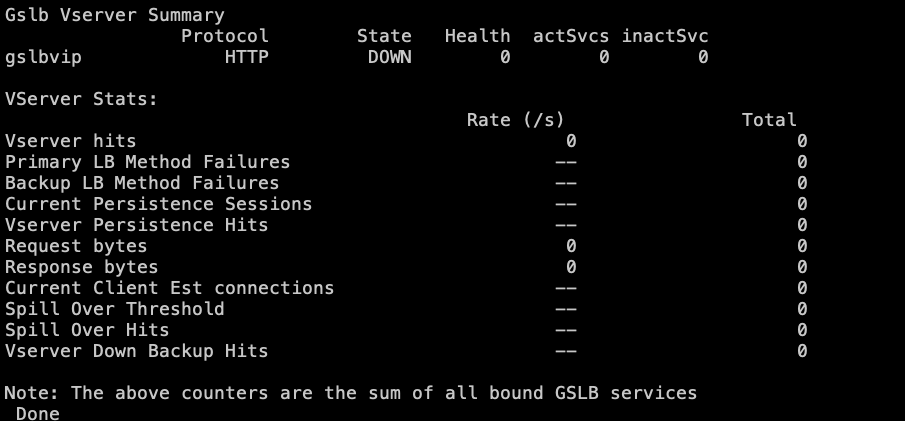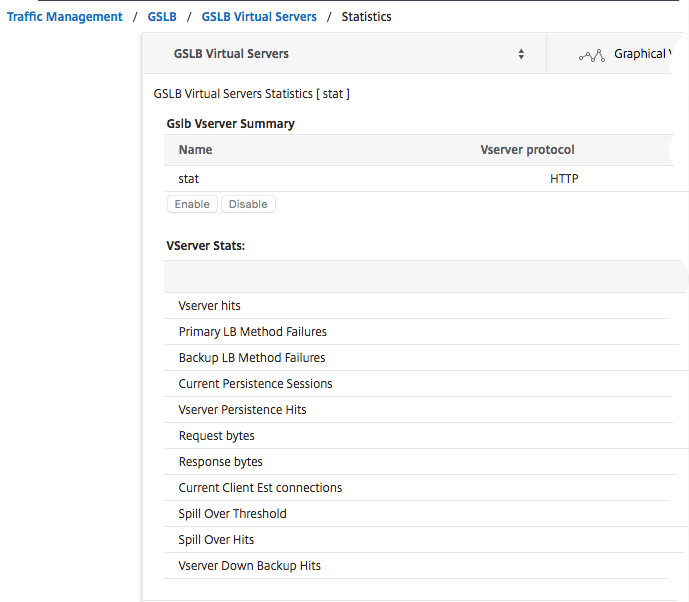-
Getting Started with Citrix ADC
-
Deploy a Citrix ADC VPX instance
-
Install a Citrix ADC VPX instance on Microsoft Hyper-V servers
-
Install a Citrix ADC VPX instance on Linux-KVM platform
-
Prerequisites for Installing Citrix ADC VPX Virtual Appliances on Linux-KVM Platform
-
Provisioning the Citrix ADC Virtual Appliance by using OpenStack
-
Provisioning the Citrix ADC Virtual Appliance by using the Virtual Machine Manager
-
Configuring Citrix ADC Virtual Appliances to Use SR-IOV Network Interface
-
Configuring Citrix ADC Virtual Appliances to use PCI Passthrough Network Interface
-
Provisioning the Citrix ADC Virtual Appliance by using the virsh Program
-
Provisioning the Citrix ADC Virtual Appliance with SR-IOV, on OpenStack
-
Configuring a Citrix ADC VPX Instance on KVM to Use OVS DPDK-Based Host Interfaces
-
-
Deploy a Citrix ADC VPX instance on Microsoft Azure
-
Network architecture for Citrix ADC VPX instances on Microsoft Azure
-
Configure multiple IP addresses for a Citrix ADC VPX standalone instance
-
Configure a high-availability setup with multiple IP addresses and NICs
-
Configure a high-availability setup with multiple IP addresses and NICs by using PowerShell commands
-
Configure HA-INC nodes by using the Citrix high availability template with Azure ILB
-
Configure address pools (IIP) for a Citrix Gateway appliance
-
-
Upgrade and downgrade a Citrix ADC appliance
-
Solutions for Telecom Service Providers
-
Load Balance Control-Plane Traffic that is based on Diameter, SIP, and SMPP Protocols
-
Provide Subscriber Load Distribution Using GSLB Across Core-Networks of a Telecom Service Provider
-
Authentication, authorization, and auditing application traffic
-
Configuring authentication, authorization, and auditing policies
-
Configuring Authentication, authorization, and auditing with commonly used protocols
-
Use an on-premises Citrix Gateway as the identity provider for Citrix Cloud™
-
Troubleshoot authentication issues in Citrix ADC and Citrix Gateway with aaad.debug module
-
-
-
-
-
-
Persistence and persistent connections
-
Advanced load balancing settings
-
Gradually stepping up the load on a new service with virtual server–level slow start
-
Protect applications on protected servers against traffic surges
-
Retrieve location details from user IP address using geolocation database
-
Use source IP address of the client when connecting to the server
-
Use client source IP address for backend communication in a v4-v6 load balancing configuration
-
Set a limit on number of requests per connection to the server
-
Configure automatic state transition based on percentage health of bound services
-
-
Use case 2: Configure rule based persistence based on a name-value pair in a TCP byte stream
-
Use case 3: Configure load balancing in direct server return mode
-
Use case 6: Configure load balancing in DSR mode for IPv6 networks by using the TOS field
-
Use case 7: Configure load balancing in DSR mode by using IP Over IP
-
Use case 10: Load balancing of intrusion detection system servers
-
Use case 11: Isolating network traffic using listen policies
-
Use case 12: Configure Citrix Virtual Desktops for load balancing
-
Use case 13: Configure Citrix Virtual Apps™ for load balancing
-
Use case 14: ShareFile wizard for load balancing Citrix ShareFile
-
-
-
-
-
Authentication and authorization
-
-
Configuring a CloudBridge Connector Tunnel between two Datacenters
-
Configuring CloudBridge Connector between Datacenter and AWS Cloud
-
Configuring a CloudBridge Connector Tunnel Between a Datacenter and Azure Cloud
-
Configuring CloudBridge Connector Tunnel between Datacenter and SoftLayer Enterprise Cloud
-
Configuring a CloudBridge Connector Tunnel Between a Citrix ADC Appliance and Cisco IOS Device
-
CloudBridge Connector Tunnel Diagnostics and Troubleshooting
This content has been machine translated dynamically.
Dieser Inhalt ist eine maschinelle Übersetzung, die dynamisch erstellt wurde. (Haftungsausschluss)
Cet article a été traduit automatiquement de manière dynamique. (Clause de non responsabilité)
Este artículo lo ha traducido una máquina de forma dinámica. (Aviso legal)
此内容已经过机器动态翻译。 放弃
このコンテンツは動的に機械翻訳されています。免責事項
이 콘텐츠는 동적으로 기계 번역되었습니다. 책임 부인
Este texto foi traduzido automaticamente. (Aviso legal)
Questo contenuto è stato tradotto dinamicamente con traduzione automatica.(Esclusione di responsabilità))
This article has been machine translated.
Dieser Artikel wurde maschinell übersetzt. (Haftungsausschluss)
Ce article a été traduit automatiquement. (Clause de non responsabilité)
Este artículo ha sido traducido automáticamente. (Aviso legal)
この記事は機械翻訳されています.免責事項
이 기사는 기계 번역되었습니다.책임 부인
Este artigo foi traduzido automaticamente.(Aviso legal)
这篇文章已经过机器翻译.放弃
Questo articolo è stato tradotto automaticamente.(Esclusione di responsabilità))
Translation failed!
Configure a GSLB virtual server
A GSLB virtual server is an entity that represents one or more GSLB services and balances traffic between them. It evaluates the configured GSLB methods or algorithms to select a GSLB service to which to send the client request.
Note
A GSLB virtual server protocol requirement is mainly to create a relation between the virtual server and the services that are bound to the virtual server. This also keeps CLI/APIs consistent for other types of virtual servers. The Service Type parameter on a service or a virtual server is not used while serving the DNS requests. It is instead referenced during site persistence, monitoring, and for doing lookups via MEP.
To create a GSLB virtual server by using the command line interface
At the command prompt, type the following commands to add a GSLB virtual server and verify the configuration:
- add gslb vserver <name> <serviceType> -ipType (IPv4 | IPv6)
- show gslb vserver <name>
<!--NeedCopy-->
Example:
add gslb vserver Vserver-GSLB-1 HTTP -ipType IPv4
add gslb vserver Vserver-GSLB-2 HTTP -ipType IPv6
show gslb vserver Vserver-GSLB-1
show gslb vserver Vserver-GSLB-2
<!--NeedCopy-->
To modify or remove a GSLB virtual server by using the command line interface
- To modify a GSLB virtual server, use the
set gslb vservercommand. This command works similar to theadd gslb vservercommand, except that you enter the name of an existing GSLB virtual server. - To reset a parameter to is default value, you can use the
unset gslb vservercommand followed by the vserverName value and the name of the parameter to be unset. - To remove a GSLB virtual server, use the
rm gslb vservercommand, which accepts only the name argument.
To configure a GSLB virtual server by using the configuration utility
- Navigate to Traffic Management > GSLB > Virtual Servers.
- Add a new GSLB virtual server, or select an existing GSLB virtual server and edit its settings.
To view the statistics of a GSLB virtual server by using the command line interface
At the command prompt, type:
stat gslb vserver <name>
<!--NeedCopy-->
Example:
stat gslb vserver Vserver-GSLB-1
<!--NeedCopy-->
To view the statistics of a GSLB virtual server by using the configuration utility
Navigate to Traffic Management > GSLB > Virtual Servers, select the virtual server and click Statistics.
GSLB virtual server statistics
Starting from Citrix ADC version 12.1 build 51.xx and later, the GSLB virtual server statistics also display the following information in addition to details such as; vserver hits, current persistence session, request bytes, response bytes, spillover threshold, spillover hits, current client established connections, and vserver down backup hits.
- Primary LB method failures: Number of times the primary GSLB method has failed.
- Backup LB method failures: Number of times the backup GSLB method has failed.
- Vserver persistence hits: The number of times the request is served through the persistence sessions.
Note: The primary or the backup method can fail when the primary method is static proximity and the backup method is RTT. In this scenario, if there is no location corresponding to LDNS IP, the static proximity fails and backup method is attempted. The statistics are updated based on the following:
- If the backup method is successful, only primary method failure statistics are incremented.
- If RTT calculation is not successful, then backup method also fails. In this case, both primary and backup method failure statistics are incremented.
When the backup method fails, the last resort method of round robin is used.
The following image is a sample of GSLB virtual server statistics from CLI.

The following image is a sample of GSLB virtual server statistics from GUI.

GSLB service statistics
When you run the stat gslb service command from the command line or click the Statistics link from the configuration utility, the following details of the service are displayed:
- Request bytes. Total number of request bytes received on this service or virtual server.
- Response bytes. Number of response bytes received by this service or virtual server.
- Current client established connections. Number of client connections in ESTABLISHED state.
- Current load on the service. Load on the service (Calculated from the load monitor bound to the service).
The data of number of requests and responses, and the number of current client and server connections may not be displayed or may not be synchronized with the data of the corresponding load balancing virtual server.
Clearing the GSLB virtual server or service statistics
Note: This feature is available in NetScaler release 10.5.e.
You can now clear the statistics of a GSLB virtual server and service. Citrix® ADC provides the following two options to clear the statistics:
- Basic: Clears the statistics that are specific to the virtual server but retains the statistics that are contributed by the bound GLSB service.
- Full: Clears both the virtual server and the bound GSLB service statistics.
To clear the statistics of a GSLB virtual server by using the command line interface
At the command prompt, type:
stat gslb vserver <name> -clearstats <basic | full>
<!--NeedCopy-->
Example:
stat gslb vserver Vserver-GSLB-1 –clearstats basic
<!--NeedCopy-->
To clear the statistics of a GSLB service by using the command line interface
At the command prompt, type:
stat gslb service <name> -clearstats <basic | full>
<!--NeedCopy-->
Example:
stat gslb service service-GSLB-1 –clearstats basic
<!--NeedCopy-->
To clear the statistics of a GSLB virtual server by using the configuration utility
- Navigate to Traffic Management > GSLB > Virtual Servers.
- Select the GSLB virtual server and, click Statistics, and then click Clear.
- From the Clear drop-down list, select Basic or Full, and then click OK.
To clear the statistics of a GSLB service by using the configuration utility
- Navigate to Traffic Management > GSLB > Services.
- Select the GSLB service and, click Statistics, and then click Clear.
- From the Clear drop-down list, select Basic or Full, and then click OK.
Enabling and Disabling GSLB Virtual Servers
When you create a GSLB virtual server, it is enabled by default. If you disable the GSLB virtual server, upon receiving a DNS request, the Citrix ADC appliance does not make any GSLB decision based on the GSLB method that is configured. Instead, the response to the DNS query contains the IP addresses of all the services bound to the virtual server.
To enable or disable a GSLB virtual server by using the command line interface
At the command prompt, type one of the following commands:
enable gslb vserver <name>@
disable gslb vserver <name>@
<!--NeedCopy-->
Example:
enable gslb vserver Vserver-GSLB-1
disable gslb vserver Vserver-GSLB-1
<!--NeedCopy-->
To enable or disable a GSLB virtual server by using the configuration utility
- Navigate to Traffic Management > GSLB > Virtual Servers.
- Select a virtual server and, from the Action list, select enable or disable.
Share
Share
This Preview product documentation is Cloud Software Group Confidential.
You agree to hold this documentation confidential pursuant to the terms of your Cloud Software Group Beta/Tech Preview Agreement.
The development, release and timing of any features or functionality described in the Preview documentation remains at our sole discretion and are subject to change without notice or consultation.
The documentation is for informational purposes only and is not a commitment, promise or legal obligation to deliver any material, code or functionality and should not be relied upon in making Cloud Software Group product purchase decisions.
If you do not agree, select I DO NOT AGREE to exit.